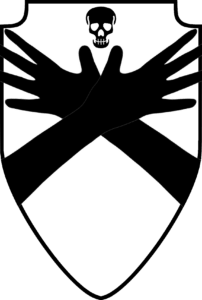The Gods of Andovir

From the start, all of the gods were unified and sang the planes and their inhabitants into existence. They sang with harmonious improvisation, adding to the song through creation: the bass drum of the giants, the clarinet elves, the xylophone dwarves, the cymbal orcs, the bar chime gnomes, the piccolo goblins, the trumpeting humans, the many strings of the dragons, and the halfling rests between notes, rarely noticed but crucial to the song. Each was another tone, another verse, another note, another chord, and we still carry those rhythms in us through our heartbeats and breathing, our innate developments of rituals and habits.
But over time, some gods felt that, to reach our full potential, we needed competition. The others argued that we are stronger together through community, but to prove their point, those who would become the Twilight Pantheon started a multiversal competition, which almost immediately devolved into war. They approved. They claimed that deception would force us to seek and better know truth, that isolation would make us desperate for unity, that hate would strengthen love, that fear would produce a longing for hope. But those vices became self-perpetuating, and the Twilight Pantheon decided that, if we would not strive for harmony, then we deserve the resulting cacophony. They affirmed their decision and intensified their efforts. We would either learn out of desperation or experience the ultimate consequences of our failure. Over time, their contempt grew until they found amusement in the strife itself, but they still keep the pretense of striving for improvement.
The Lords of Light held that those who know truth can spot deception and that no one threat is stronger than an infinite diverse community. They held that hope and love provide greater lasting motivation for goals that benefit all creatures.
The pantheon of Andovir is divided into two opposing forces: the Lords of Light and the Twilight Pantheon. The Lords of Light embody compassion, generosity, loyalty, and truth, guiding mortals toward unity, peace, and the flourishing of life. Their teachings focus on uplifting others, fostering community, and protecting the vulnerable. In contrast, the Twilight Pantheon thrives on self-interest, deception, and manipulation, prioritizing personal power and survival at any cost. Where the Light seeks balance and growth, the Twilight embraces ambition, indulgence, and the relentless pursuit of control, often through destruction or domination. This duality shapes the spiritual and moral landscape of Andovir, as followers choose between selfless service and self-centered ambition.
Lords of Light
Philosyne
 Titles: Defender of the weak, Servant King, Builder of lives
Titles: Defender of the weak, Servant King, Builder of lives
Divine rank: Greater God
Position: God of Compassionate Love
Holy symbol: Two hands, one pulling the other up
Alignment: Neutral Good
Cleric alignments: Any Good
Portfolio: Love, compassion, peace, forgiveness
Domains: Arcana, Life, Light, Protection, War
Favored weapon: Philosyne’s followers prefer entangling weapons like mancatchers and chain weapons with the intent of incapacitating opponents. They also prefer spiked bucklers to use against entangled opponents. Other preferred weapons include tools that can also function as weapons. They eschew weapons whose only function is to kill and destroy.
Appearance: Philosyne appears as an older man in plain clothes with worn knees, a smile on his face, like a friendly grandpa, typically of the same ancestry as those around him. His hands are calloused and strong but gentle. Philosyne frequently manifests on the Prime Material Plane, actively helping the disadvantaged and marginalized. However, he remains inconspicuous, operating in the background to empower and inspire others, often going unnoticed until after his intervention. Philosyne is often accompanied by his wife, Amara, embodying the synergy of compassion and love.
Realm: Philosyne and his servants can usually be found around Elysium and the other upper planes, helping others wherever they can and coordinating with other beings to plan for the greater good.
Dogma, clergy and temples: Philosyne’s temples are multifaceted structures designed to serve the community. They encompass conference rooms, workshops, lounges, and planning areas to organize and prepare for community outreach and aid.
Tenets: Philosyne’s teachings center around compassionate love and selfless acts. They emphasize that Philosyne’s love encompasses all individuals, enabling their followers to trust in that love and dedicate themselves to serving others. Philosyne encourages their followers to experience the divine love and, in turn, teach others the joy of loving and serving.
Deity’s Paladins Code: Paladins of Philosyne vow to champion the defenseless and forsake personal quests when encountering individuals in dire need. They prioritize the well-being and protection of those who cannot defend themselves.
Sects and Cults: The Opheilo cult of Philosyne has taken the self-sacrifice concept but lost the freedom, turning self-sacrifice into a demanding requirement, so personal injuries and even sacrificing relationships become a badge of honor. They function on guilt in a constant effort to pay back Philosyne’s love for them, but the leadership “provides opportunities to serve” by taking advantage of members and making cruel demands, doing little or no service for anyone themselves.
Affiliated Lesser Beings: Philosyne holds respect for all beings, seeking their well-being and growth, even extending their compassion to evil beings. While Philosyne aims to guide them towards the path of goodness, they will intervene to protect the defenseless from harm caused by evil entities. This inclusive approach has earned Philosyne a commendable reputation among all good-aligned creatures. However, neutral beings may view Philosyne as overly idealistic, while evil beings often attempt to exploit their compassion. Philosyne allows some manipulation, but always with a plan to bring about positive outcomes for others.
Eudoxia
 Titles: Giver of all good gifts, The Source
Titles: Giver of all good gifts, The Source
Divine rank: Greater Goddess
Position: Goddess of Generosity
Holy symbol: Liquid flowing into an overflowing cup
Alignment: Neutral Good
Cleric alignments: Any Good
Portfolio: Generosity, resource management, creativity and artistry, celebration and parties, food and drink
Domains: Knowledge, Life, Protection, Forge, War
Favored weapon: Eudoxia favors weapons that can be used as tools, like hammers for the forge, knives for craftsmanship, polearms for agriculture, and other multi-purpose implements. Eudoxia also prefers missile weapons, an ironic twist on the concept of giving far and wide.
Appearance: Eudoxia appears as a graceful woman of the same ancestry as those around her, embodying the beauty of generosity She dresses as a woman of high social status and has a presence of respectability, but she wears modest jewelry. She always wears a purse and is often depicted carrying a bowl and cup in times of peace or her longbow and quiver of endless arrows in times of war.
Realm: While Eudoxia calls Elysium home, her magnificent estate in Amoria hosts a never-ending party, and she’s often found celebrating with friends in the Twin Paradises or on hunts in the Happy Hunting Grounds.
Dogma, clergy and temples: While the core of Eudoxia-worship is generous giving to others, she doesn’t require poverty. Eudoxia gives to her adherents that they may give of her abundance to others. In order to best use her gifts, adherents are encouraged to invest their resources wisely and use their possessions and positions for others. Her temples are filled with ornate artwork and carvings, their halls echoing with music, but with few precious metals or jewels, preferring the value to be in the craftsmanship, not the cost of the materials. Every temple of Eudoxia also has a large ballroom reserved for feeding and sheltering the poor and for hosting quarterly balls, to which all are invited, rich and poor.
Tenets: The core principle of Eudoxia’s worship centers around generous giving and selfless acts. Followers place their trust in Eudoxia’s abundant blessings and are encouraged to share her gifts by supporting the temple’s service work, employing their artistic talents to enrich the community, and extending assistance to those in need.
Deity’s Paladins Code: Paladins of Eudoxia prefer ornate and beautiful armor and weapons as a testament to her generosity. They also carry additional supplies of food and resources reserved explicitly for aiding those they encounter who are in need.
Sects and Cults: The Dispensia sect encourages adherents to contribute their possessions to the leaders, who, in theory, redistribute them to address communal needs. However, in practice, these leaders often retain the majority for themselves. Some areas have experienced coercion from the cult, forcing impoverished villages to surrender their resources under the guise of generosity while the leaders luxuriate in opulence. They have been known to use henchmen to ensure the generosity of the citizens.
Affiliated Lesser Beings: Eudoxia is especially loved by fey for her artistic emphasis and her constant celebration.
Amara
 Titles: The Ever-Present, The Unwavering, The Faithful
Titles: The Ever-Present, The Unwavering, The Faithful
Divine rank: Greater Goddess
Position: Goddess of Loyalty
Holy symbol: Interlocking hearts
Alignment: Lawful Good
Cleric alignments: Lawful Good or Lawful Neutral
Portfolio: Loyalty, commitment, friendship, promises, community, devotion
Domains: Life, light, protection, war
Favored weapon: Amara prefers weapons composed of two connected pieces, like nunchaku and flails.
Appearance: Amara appears as a kind elderly woman of the same ancestry as those around her. She dresses in humble local clothing, reflecting her affinity for simplicity and devotion.
Realm: As Philosyne’s wife, Amara spends much of her time at his side. When they’re not together, she enjoys spending time building friendships with beings from Nirvana to Elysium, and as such, if she or her followers are threatened, many available beings will respond in kind to her loyalty by fighting in her name.
Dogma, clergy and temples: Amara-worshippers are known for their complex harmonious music, liturgies, and greetings. When Amara-worshippers meet each other, they sometimes take several minutes to greet each other with responsive greetings, an expression of unity: “Amara is with you.” “She will never leave us.” “Her faithfulness never ends.” And back and forth it goes, sometimes spoken, sometimes transitioning to music as their smiles grow. Amara’s temples serve as community centers where all ages and faiths are welcome, and her festivals take the form of carnivals or team sporting events.
Tenets: Amara’s teachings center in her faithfulness to her followers, so they respond in faithfulness to others. Her followers strive to uphold their promises, fulfill their obligations, and remain steadfast in their commitments to others.
Deity’s Paladins Code: Paladins of Amara strive to never break a promise. They’re also intensely loyal to their friends, fellow Amara-worshippers and Philosyne-worshippers, and will never give up defending or rescuing one to whom they’ve sworn loyalty, but they exercise discretion and wisdom, retreating in the face of insurmountable odds to strategize and plan a successful rescue.
Sects and Cults: The Erimus cult takes a hard line on their rituals and, for the sake of agreement, reject all rituals past the date of the cult’s founding to be heretical. Consequently, they hate the mainline Amara religion and refuse to participate in Amara’s festivals and sometimes even sabotage them. They do have their own quarterly festivals, but because they fall on the same dates as mainline Amara festivals and are more subdued (using the same music, food, and games every year), communities tend to attend the mainline festivals instead. Unlike other followers of the Lords of Light who engage in worship across multiple deities, the Erimus cult solely worships Amara and remains socially isolated within their communities.
Affiliated Lesser Beings: Amara’s emphasis on relationships and friendships endears her to various peoples and beings. She particularly holds a special place in the hearts of halflings, tiggywinkles, and other “hearth folk.” However, many beings from diverse planes, including the chaotic realms, consider themselves “friends of Amara,” a sentiment she wholeheartedly reciprocates.
Luminaris
 Titles: Illuminator of Truth, The Guiding Beacon, Revealer of Mysteries
Titles: Illuminator of Truth, The Guiding Beacon, Revealer of Mysteries
Divine rank: Greater God
Position: Truth and Justice
Holy symbol: Lantern with an eye instead of a flame
Alignment: Lawful Good
Cleric alignments: Lawful Neutral or any Good, must also have INT 12+
Portfolio: Truth, Knowledge, Justice, Light
Domains: Arcana, Life, Light, Protection, Knowledge
Favored weapon: Luminaris prefers piercing weapons, which more easily get under the armor that conceals the true nature of an enemy.
Appearance: Luminaris appears as a genderless being, mirroring the ancestry of those around them. They wear a luminous crown adorned with eye-like gems. Their radiant presence shines so brightly that it renders non-divine beings blinded when they attempt to look directly at them. The light emitted by Luminaris eliminates shadows within a 1000 foot radius and inflicts 100 hp radiant damage per round on creatures from the Demiplane of Shadow.
Realm: Luminaris lives in a gleaming castle in Lunia and holds court in their massive judgment hall. The rest of the castle consists of libraries and lavish housing for those executed for crimes they didn’t commit.
Dogma, clergy and temples: Luminaris’s temples are brightly lit, open spaces, using massive arches to eliminate the need for support columns besides those built into the outer walls. They serve as public libraries, schools, and housing for refugees, abuse victims, and all those who face injustice. Clerics of Luminaris focus on social justice, actively aiding the marginalized and persecuted. They engage in intellectual and legal battles, prioritizing non-violent methods to defend those who cannot protect themselves.
Tenets: Centered on truth, including the exposure of falsehoods that perpetuate injustice, Luminaris’s followers strive for honesty and abhor deception. When faced with a problem, they seek its root cause, firmly believing that “light can banish the deepest darkness.”
Deity’s Paladins Code: Paladins of Luminaris are duty-bound to intervene whenever they encounter unjust persecution or abuse. They will alter their current path to provide aid to those in need to the best of their abilities. In cases of systemic injustice, they strive to establish local efforts to combat the wrongdoing or call for reinforcements when necessary.
Sects and Cults: The Aletheia cult is a Lawful Neutral cult that emphasizes truth at all costs. While the mainstream Luminaris followers emphasize truth for the benefit of others, the Aletheia see themselves as guardians of truth, or their version of the truth, at the expense of others. They’re known more for what they’re against than what they’re for, and they’re best known for their persecution of Tieflings.
Affiliated Lesser Beings: Luminaris is revered and cherished by creatures of Law and those who seek knowledge for the benefit of others. Dwarves, in particular, tend to hold a deep affection for Luminaris.
Elowen
 Titles: The Inherent Beauty, The Verdant Muse
Titles: The Inherent Beauty, The Verdant Muse
Divine rank: Greater Goddess
Position: Goddess of Beauty and Nature
Holy symbol: Acorn
Alignment: Chaotic Good
Cleric alignments: Any non-evil
Portfolio: Nature, beauty, life, creation
Domains: Life, Nature, Protection, Trickery, Tempest
Favored weapon: Elowen prefers weapons crafted from natural materials, such as wooden staffs, bone daggers, or stone-tipped arrows. She encourages her followers to avoid metal weapons that disrupt the harmony of the natural world.
Appearance: Elowen takes the form of a captivating fairy with radiant brown skin and flowing green hair. She adorns her head with a wreath made of leaves, flowers, berries, and acorns, symbolizing the bounty of nature. She wears a simple blue dress that flows like a waterfall.
Realm: While Elowen delights in exploring and enhancing the beauty of the Prime Material Plane, she also finds solace in the lush upper planes, reveling in their verdant landscapes.
Dogma, clergy and temples: Elowen’s temples are forest glades, flowering prairies, and desert oases. Her clergy (mostly druids) seek to care for creation even while they let creation care for others. All of Elowen’s clerics are trained in herbalism and/or animal handling and wilderness survival, and they love to get their hands dirty enjoying the gifts Elowen gives through nature.
Tenets: Elowen’s followers believe that nature is a reciprocal gift to be managed responsibly and to enjoy. They treat the natural world as a friend, savoring every gift it brings and seeking to give back even more.
Many of Elowen’s followers, especially the fey and clerics, tattoo their faces with elaborate natural designs.
Deity’s Paladins Code: Paladins of Elowen wield weapons crafted solely from natural materials, such as wooden staffs with stone tips or bone blades. They exhibit conscientiousness toward their impact on the land and actively strive to leave minimal ecological footprints. Whenever the need arises to fell a tree, they pledge to plant two new saplings in its place. Additionally, when encountering wounded animals, they prioritize nursing them back to health, even if it inconveniences their party.
Sects and Cults: The Sylvan Circle is composed of elves and other fey who see all other humanoid races as a blight on the earth. They only eat fruit and nuts that have fallen from trees or animals that have died of natural causes, not wanting to kill any of Elowen’s creatures, although they have no problem with violence against “the blight,” often sabotaging mills, farming equipment, and other equipment and facilities used to “murder the earth.” They’re also known to set domesticated animals free, and when pets or other loyal animals don’t run away, they kill the animals. “Better saved than slaved!”
Affiliated Lesser Beings: As Elowen’s focus is more obvious above ground, she’s particularly loved by elves and other fey.
Twilight Pantheon
Svayam
 Titles: Lord of Survival, The Preserver, Giver of Immortality
Titles: Lord of Survival, The Preserver, Giver of Immortality
Divine rank: Greater God
Position: God of Self-Preservation
Holy symbol: A kite shield with arms crossed as if hugging itself and a skull at the top
Alignment: Chaotic Evil
Cleric alignments: Non-Lawful Neutral or Evil
Portfolio: Self-preservation, War, Undead
Domains: Death, grave, protection, trickery, war
Favored weapon: Svayam only uses 1-handed weapons so he can always use a shield to protect himself.
Appearance: Svayam always appears in red full-plate armor with a kite shield and longsword.
Realm: Svayam resides on an undisclosed plane of the Abyss, but his influence extends far beyond a single plane. He keeps his location secret to protect himself but uses extensive magical wards and traps. He uses minions but trusts only the undead under his direct control.
Dogma, clergy and temples: Svayam teaches self-preservation above all. His clerics often speak of immortality and eternal life, but those terms refer to necromancy and the undead. They speak of protection and preservation, but ultimately only of themselves. Svayam’s worship involves dark rituals and the exploitation of the vulnerable, though they maintain plausible deniability. Svayam’s temples often offer care for the elderly, serving as both income source and future undead recruits. Clerics collaborate closely due to mutual suspicion. Assassins’ guilds frequently ally with local Svayam temples.
Tenets: Svayam’s teachings revolve around self-preservation through mistrust and deception. The most revered followers are those who outwit their peers.
Deity’s Paladins Code: Svayam’s Paladins never go into battle without a shield. They also only fight when the personal benefit vastly outweighs the risk, or they have some perceived guarantee that they will be restored by some means if fallen in battle.
Sects and Cults: Some Svayam cults follow the Shadowbinders sect, which has a greater emphasis on murder for necromantic purposes. A city with a Shadowbinders sect will eventually become a horrifying nest of undeath. Many of these sects are secretly led by vampires or other powerful sentient undead.
Affiliated Lesser Beings: Svayam is revered by necromancers and those seeking to extend their existence at any cost. Svayam is also the patron of many sentient aberrations, some of whom covertly lead Svayam temples.
Velara
 Titles: Wealth of the world, Mistress of all the Sparkles, The Most Precious Jewel, The Merry Heart
Titles: Wealth of the world, Mistress of all the Sparkles, The Most Precious Jewel, The Merry Heart
Divine rank: Greater Goddess
Position: Possessions (Greed)
Holy symbol: A jewel-covered tiara
Alignment: Neutral Evil
Cleric alignments: Any non-good
Portfolio: Wealth, deception, avarice, illusion, rogues, indulgence
Domains: Trickery, Illusion, Protection, Knowledge
Favored weapon: Velara never engages in direct combat. That’s what attendants are for! Her clerics, as her defenders, prefer quick weapons that can be used with panache, especially light swords like rapiers and other finesse weapons, avoiding blunt weapons and pole arms.
Appearance: Velara appears as middle-aged dwarven woman wearing excessive jewelry, a fancy dress woven with jewels and threads of precious metals, and always carrying a purse full of money. She’s constantly surrounded by attendants, catering to her every desire.
Realm: Velara lives in a great gold and ivory castle carved into a mountainside on Colothys, tended by enslaved fiends, dragons, and the souls of her deceased followers, each of which wears golden shackles around neck, arms, and legs with chains that fade away at a distance but are all within reach of Velara.
Dogma, clergy and temples: Velara’s temples are places of opulent wealth, white marble adorned with precious metals and jewels, at least one dragon statue, and an altar that appears to be four dwarves holding a slab of marble above their heads, all guarded by elite swordsmen at all times. Her clerics typically have close ties with local thieves’ guilds. They offer wealth and riches to their adherents, typically run ponzi schemes and other deceptive swindles that pull their adherents in deeper and deeper. Every temple also includes a casino.
Tenets: Each adherent pledges 20% of their income to a patron, becoming patrons themselves to those they convert into Velara’s worship, creating a pyramid scheme of wealth. All patrons must also contribute 20% of their earnings to the local temple, with a high priestess overseeing these contributions. Half of these earnings are invested in temple operations, while the rest is retained by the high priestess.
Deity’s Paladins Code: All paladins must give 50% of their earnings to the local temple in addition to their patron earnings. They also typically run protection rackets in the community surrounding the temple.
Sects and Cults: The Hidden Web, typically a secret faction within a local Velara hierarchy, focuses on driving people into debt with loan sharks, fraud, and drug addiction. Once individuals are ensnared by debt, they are coerced into indentured servitude and other exploitative practices, forever bound by their debts.
Affiliated Lesser Beings: Velara is the queen of all dragons and believed by many to be their mother, alongside Svayam. Even though many dragons aren’t evil, their obsession with material wealth makes them attracted to Velara. Few dragons ever break her hold on them. She also enthralls many dwarves, and her temples can be found in most dwarven cities. Many other marketplaces, breweries, and thieves’ guild headquarters include shrines to Velara.
Erimara
 Titles: The Temptress, Mistress of Illusion, Lady of Discontent
Titles: The Temptress, Mistress of Illusion, Lady of Discontent
Divine rank: Greater Goddess
Position: Hedonism (Desire)
Holy symbol: An inverted heart with a keyhole in the middle
Alignment: Chaotic Evil
Cleric alignments: Neutral Evil or Chaotic Evil
Portfolio: Sensual pleasure, unfulfilled desires
Domains: Trickery, Illusion, Tempest, Knowledge
Favored weapon: Erimara favors weapons that manipulate perception and inflict psychological torment, such as whips or daggers with hallucinogenic toxins.
Appearance: Erimara takes the form of an irresistibly alluring woman, dressed in seductive attire that reflects the desires of those who gaze upon her. She’s always accompanied by several succubi/incubi but is noticeably more attractive than her attendants.
Realm: Erimara rules a layer of the Abyss in a dark castle filled with red and violet velvet and silk. The halls echo with the anguish of those whom her religion seduced in life who spend eternity facing offers of all they desire but never attaining fulfillment.
Dogma, clergy and temples: Erimara’s temples are opulent halls of sensory indulgence, designed to captivate the desires of mortals. The clergy of Erimara employ elaborate illusions and intoxicating scents to entice their followers. These temples serve as havens for those seeking to pursue their deepest desires, although the ultimate result is an insatiable craving that leaves one feeling unfulfilled and unsatisfied.
Tenets: Erimara teaches that the pursuit of pleasure and desire is the ultimate goal in life. However, her followers are encouraged to constantly seek new sensations and experiences, never allowing themselves to truly find lasting fulfillment. They believe that the journey of desire is more important than the destination.
Deity’s Paladins Code: Erimara’s paladins, known as Eclipsed Souls, serve as enforcers of her will. Their duty is to manipulate the desires of others, exploiting their weaknesses and leading them down a path of unfulfilled longing. They sow discord and chaos in relationships, driving mortals into an eternal cycle of dissatisfaction.
Sects and Cults: The Delirium Coven is a sect devoted to Erimara that specializes in weaving intricate illusions and casting spells of enchantment. They lure unsuspecting victims into a web of deceit, promising boundless pleasure and fulfillment, only to deliver a perpetual state of emotional emptiness and despair.
Affiliated Lesser Beings: Erimara is served by and associated with various demons and undead with life draining abilities.
Zyraeth
 Titles: The Wise Eye, The Be Cause
Titles: The Wise Eye, The Be Cause
Divine rank: Greater God
Position: God of Pragmatism
Holy symbol: A gray amorphous shape with a faded gradient around the edges
Alignment: Chaotic Neutral
Cleric alignments: Any chaotic
Portfolio: Situational ethics, expediency, resourcefulness
Domains: Arcana, knowledge, trickery, tempest
Favored weapon: Zyraeth has no preferred weapon. Practicality eliminates such requirements.
Appearance: Zyraeth appears in whatever humanoid form is most expedient for the situation, but is always recognizable by a distinctive mark over one eye.
Realm: Zyraeth has multiple cottages and fortresses on Pandesmos and Cocytus, living wherever his whims take him. These buildings have shifting walls and corridors and often lead randomly to other planes, although Zyraeth can use them flawlessly.
Dogma, clergy and temples: Zyraeth’s temples are constructed using whatever resources are most readily available, even if it inconveniences others. Clerics often contradict each other, and the teachings of one temple may drastically differ from another. This can lead to rivalry between temples, and alliances with others, including temples of other deities.
Tenets: Zyraeth is a god of adaptability and contradiction, requiring flexibility from his followers. His wisdom must not be questioned, even when it contradicts previous statements. The end always justifies the means.
Deity’s Paladins Code: Zyraeth’s paladins choose their own code with a specific action requirement and a prohibition, then must follow that code to the letter always – until it becomes impractical, at which point they must create a new code.
Sects and Cults: Every temple of Zyraeth is essentially its own sect, adapting to local circumstances and opportunities.
Affiliated Lesser Beings: Zyraeth is the most popular deity among opportunistic humanoid races. He is also believed to have tenuous alliances with multiple creatures of chaos but is ultimately trusted by no one, as befits his nature.
Zalthrax
 Titles: The Highest of the High and Greatest of the Great
Titles: The Highest of the High and Greatest of the Great
Divine rank: Greater God
Position: Ambition and Personal Advancement (at any cost)
Holy symbol: A set of 3 steps with a boot on the top step
Alignment: Neutral Evil
Cleric alignments: Any evil
Portfolio: Ambition, social climbing, political manipulation, competition
Domains: Arcana, knowledge, trickery, war
Favored weapon: Zalthrax prefers blunt weapons, especially hammers, that flatten the opposition.
Appearance: Zalthrax appears as a middle-aged individual, adapting to the appearance that suits the situation best, usually dressed in the clothing most closely associated with the local wealthy, but always wearing some kind of boots.
Realm: Zalthrax rules supremely over Oinos atop an obsidian tower. Inside, a staircase with steps of random heights ascends from the ground to the top, populated by various fiends, but it’s impossible to ever reach the top, no matter how many steps one climbs. That said, the steps are not a loop, so beings who fall will fall down the entire distance they’ve climbed thus far.
Dogma, clergy and temples: Zalthrax’s clergy adheres to a strict hierarchy, engaging in fierce competition for positions of power within the cult. Temples dedicated to Zalthrax are constructed in a ziggurat-like shape, with increasingly deadly traps as one ascends higher. Clergy members often hold influential government positions, utilizing their power to further their ambitions. Temples are sustained by contributions from adherents.
Tenets: Adherents must pay dues based on income and position in the hierarchy. The rate is regressive, with those at the bottom paying the highest percentage. Adherents constantly strive to seek the highest level in their occupation at whatever cost, sacrificing reputation, family, friends, the well-being of others, or anything else deemed necessary.
Deity’s Paladins Code: Paladins constantly strive for position and will undermine the leader of a party if necessary to attain a position of leadership. They also oversee the enforcement of hierarchies and the collection of tithes.
Sects and Cults: While most Zalthrax adherents operate primarily by manipulation and political maneuvering, the Ascendants are known for preferring overt displays of power, including violence, to gain and maintain their positions.
Affiliated Lesser Beings: Zalthrax is is revered especially by ambitious and ruthless humanoids. He also has a number of powerful beings serving under him, each constantly vying for his favor and a higher position in his hierarchy.